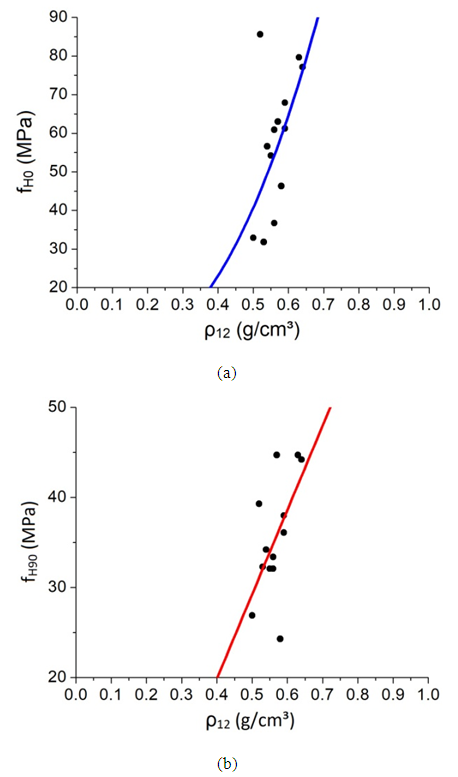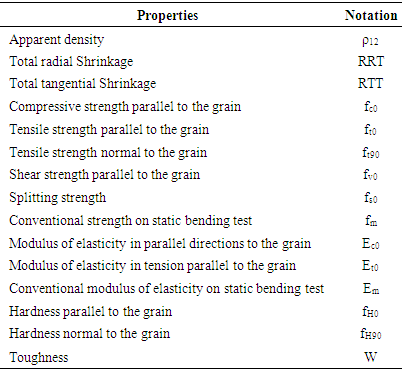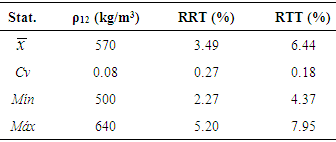-
Paper Information
- Next Paper
- Previous Paper
- Paper Submission
-
Journal Information
- About This Journal
- Editorial Board
- Current Issue
- Archive
- Author Guidelines
- Contact Us
International Journal of Materials Engineering
p-ISSN: 2166-5389 e-ISSN: 2166-5400
2018; 8(5): 97-100
doi:10.5923/j.ijme.20180805.03

Physical and Mechanical Characterization of Cedrelinga catenaeformis Ducke Wood Specie
Vinicius Borges de Moura Aquino1, Diego Henrique de Almeida1, Tiago Hendrigo de Almeida2, Tulio Hallak Panzera3, André Luis Christoforo1, Francisco Antonio Rocco Lahr4
1Department of Civil Engineering (DECiv), Federal University of São Carlos (UFSCar), São Carlos, Brazil
2Department of Science and Material Engineering, São Carlos Engineering School (SMM), São Carlos, Brazil
3Centre for Innovation and Technology in Composites (CITeC), Department of Mechanical Engineering, Federal University of São João del-Rei, São João del-Rei, Brazil
4Department of Structural Engineering (SET), São Carlos Engineering School, São Paulo University (EESC/USP), São Carlos, Brazil
Correspondence to: André Luis Christoforo, Department of Civil Engineering (DECiv), Federal University of São Carlos (UFSCar), São Carlos, Brazil.
| Email: |  |
Copyright © 2018 The Author(s). Published by Scientific & Academic Publishing.
This work is licensed under the Creative Commons Attribution International License (CC BY).
http://creativecommons.org/licenses/by/4.0/

Wood, a natural and sustainable resource, has been used by humankind for several purposes especially in construction and some manufacturing sectors. Due to predatory harvest of well-known wood species and in consequence, possible shortage of these essences, it is indispensable to characterize new wood species. This study intended to determine, under the requirements of Brazilian Code ABNT NBR 7190, the mechanical and properties of Cedroarana wood (Cedrelinga catenaeformis Ducke). Besides, with the analysis of variance (ANOVA), testing several regression models, it has hoped to estimate the values of strength and stiffness as a function of apparent density. Thirteen specimens were used for each test, totalizing 195 experimental results. The mechanical properties of Cedrelinga catenaeformis obtained demonstrated compatible performance with regular wood species used in temporary civil construction. According the regression models, only two properties were considered significant with apparent density estimation.
Keywords: Characterization, Cedrelinga cateaeniformis Ducke, Regression model, Analysis of variance (ANOVA)
Cite this paper: Vinicius Borges de Moura Aquino, Diego Henrique de Almeida, Tiago Hendrigo de Almeida, Tulio Hallak Panzera, André Luis Christoforo, Francisco Antonio Rocco Lahr, Physical and Mechanical Characterization of Cedrelinga catenaeformis Ducke Wood Specie, International Journal of Materials Engineering , Vol. 8 No. 5, 2018, pp. 97-100. doi: 10.5923/j.ijme.20180805.03.
Article Outline
1. Introduction
- Wood is an important and sustainable material employed in several sectors and industries of different segments nowadays and it has been used to quench humankind demands, like store food, construction of shelters and agricultural tools. To use of wood rationally in a large range of possibilities, the knowledge of its anatomical, chemical, physical and mechanical properties is crucial. The use of wood also meets the requirements that the current environmental appeal of products and services provided by man [1-4].Considering the high-level demand and few options of well-known wood species for structural construction and manufacture purposes, predatory and selective harvesting has reduced market receptivity for new species whose characteristics and properties are not yet known. In consequence, the prices on market were meanly affected and it got confirmed it is indispensable to define new species to replace the traditional ones used in building construction [1, 3]. Thus, Cedrelinga catenaeformis Ducke appears as a very interesting option, especially to Brazilian Amazonian Region, the west and southeast part of Brazilian country, where the occurrence of this wood specie is more noticeable [5].Brazilian Code ABNT NBR 7190 [6], in its Annex B, defines the tests to proceed wood characterization, i.e., the determination of its physical and mechanical properties for structural purposes. However, it is timely to register the high number of required tests, aspect that causes a high cost for wood characterization (equipment and services). Besides, it must be remembered that some specific testing machines are available only in research centers.In this context, it seems important to search alternatives to reduce costs and, in this paper, it is intended to correlate all mechanical properties with density. Once demonstrated this possibility, it could generate decrease in costs and in time required to properties estimation.Density is a physical property of easy experimental determination, defined by the ratio between the mass and volume of the sample at 12% moisture. Considering that density is a fundamental property, its values can endorse determining an appropriate estimate of some wood properties [1, 2, 7, 8, 9]. The estimation of strength and stiffness properties by density via mathematical methods (regression methods) could enable the engineers a better pre-design of the structure.Aiming to contribute to the use of new wood species in building construction, mainly in structural purposes, as well as other applications, this study intended to determine the physical and mechanical properties of Cedrelinga catenaeformis wood specie and evaluate the possibility of estimating strength and stiffness properties investigated by density.
2. Material and Methods
- The wood samples of the Cedrelinga catenaeformis has been properly stored, with close to 12% moisture content, and this is the moisture balance established by the Brazilian Code [6].All tests were carried out on the Wood and Timber Structures Laboratory (LaMEM), Department of Structural Engineering (SET), São Carlos Engineering School (EESC), University of São Paulo (USP).The physical and mechanical properties (Table 1) were obtained according to the assumptions and calculation methods given by the Brazilian Code ABNT NBR 7190 [6] (Timber Structures Design), provided on its Annex B. It should be noted that 13 values for each one of its physical (3) and mechanical properties (12) were investigated, resulting in 195 experimental values obtained.
|
 | (1) |
 | (2) |
 | (3) |
 | (4) |
3. Results and Discussion
- Tables 2 and 3 shows the mean values
 coefficient of variation (Cv), the lowest (Min) and the highest (Max) of the physical and mechanical properties of the Cedrelinga catenaeformis Ducke wood, respectively.
coefficient of variation (Cv), the lowest (Min) and the highest (Max) of the physical and mechanical properties of the Cedrelinga catenaeformis Ducke wood, respectively.
|
|
|
|
 | Figure 1. Best fit obtained to estimate the strength values of wood by apparent density - geometric (a) and linear (b) models |
4. Conclusions
- The results of this study permit us to conclude:- According to the Brazilian Code, Cedrelinga catenaeformis Ducke characterization can be considered adequate, observing the values of the coefficients of variation.- Following the disposed Brazilian Code, Cedrelinga catenaeformis Ducke is classified as C20 strength class due its characteristic value of strength in compression parallel to grain, implying a potential performance in manufacture and constructions, except for structural purpose.- According the values of the coefficient of determination reached form the adjustments, the regression models presented significant estimates for: hardness parallel and normal to the grain. It demonstrate the relation between these properties and the apparent density but unable to use them as an estimator of these properties due its poor adjustment.
ACKNOWLEDGEMENTS
- For all the provided support, the authors thank the Coordenação de Aperfeiçoamento de Pessoal de Nível Superior (CAPES) and the Conselho Nacional de Desenvolvimento Científico e Tecnológico (CNPq).
 Abstract
Abstract Reference
Reference Full-Text PDF
Full-Text PDF Full-text HTML
Full-text HTML



